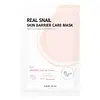What's inside
What's inside
 Key Ingredients
Key Ingredients

 Benefits
Benefits

 Concerns
Concerns

 Ingredients Side-by-side
Ingredients Side-by-side

Water
Skin ConditioningGlycerin
HumectantPropanediol
SolventBetaine
HumectantDipropylene Glycol
HumectantHydroxyacetophenone
AntioxidantPanthenol
Skin ConditioningAmmonium Polyacryloyldimethyl Taurate
Emulsion StabilisingCaprylyl Glycol
EmollientPolyglyceryl-10 Laurate
Skin ConditioningT-Butyl Alcohol
Perfuming1,2-Hexanediol
Skin ConditioningButylene Glycol
HumectantLavandula Hybrida Oil
EmollientSodium Hyaluronate
HumectantHydrolyzed Corn Starch
HumectantDipotassium Glycyrrhizate
HumectantSucrose
HumectantSnail Secretion Filtrate
Skin ConditioningDisodium EDTA
Linalool
PerfumingWater, Glycerin, Propanediol, Betaine, Dipropylene Glycol, Hydroxyacetophenone, Panthenol, Ammonium Polyacryloyldimethyl Taurate, Caprylyl Glycol, Polyglyceryl-10 Laurate, T-Butyl Alcohol, 1,2-Hexanediol, Butylene Glycol, Lavandula Hybrida Oil, Sodium Hyaluronate, Hydrolyzed Corn Starch, Dipotassium Glycyrrhizate, Sucrose, Snail Secretion Filtrate, Disodium EDTA, Linalool
Water
Skin ConditioningSnail Secretion Filtrate 40%
Skin ConditioningPropanediol
SolventDicaprylyl Carbonate
EmollientPolyglyceryl-3 Methylglucose Distearate
EmulsifyingNiacinamide
Smoothing1,2-Hexanediol
Skin ConditioningMelaleuca Alternifolia Leaf Extract
PerfumingCentella Asiatica Extract
CleansingButylene Glycol
HumectantCyclomethicone
EmollientCetearyl Alcohol
EmollientSqualene
EmollientGlyceryl Stearate
EmollientCarbomer
Emulsion StabilisingTromethamine
BufferingCitrus Aurantium Bergamia Fruit Oil
MaskingSodium Polyacrylate
AbsorbentMadecassoside
AntioxidantEthylhexylglycerin
Skin ConditioningArtemisia Princeps Leaf Extract
Skin ConditioningHydrolyzed Collagen
EmollientGlycerin
HumectantAdenosine
Skin ConditioningDisodium EDTA
Salvia Officinalis Oil
MaskingTocopherol
AntioxidantHydrolyzed Vegetable Protein
Skin ConditioningHydrogenated Lecithin
EmulsifyingAsiaticoside
AntioxidantMadecassic Acid
Skin ConditioningAsiatic Acid
Skin ConditioningStearic Acid
CleansingCeramide NP
Skin ConditioningCeramide Ns
Skin ConditioningPhytosphingosine
Skin ConditioningCholesterol
EmollientCeramide As
Skin ConditioningCeramide AP
Skin ConditioningCeramide EOP
Skin ConditioningLimonene
PerfumingLinalool
PerfumingWater, Snail Secretion Filtrate 40%, Propanediol, Dicaprylyl Carbonate, Polyglyceryl-3 Methylglucose Distearate, Niacinamide, 1,2-Hexanediol, Melaleuca Alternifolia Leaf Extract, Centella Asiatica Extract, Butylene Glycol, Cyclomethicone, Cetearyl Alcohol, Squalene, Glyceryl Stearate, Carbomer, Tromethamine, Citrus Aurantium Bergamia Fruit Oil, Sodium Polyacrylate, Madecassoside, Ethylhexylglycerin, Artemisia Princeps Leaf Extract, Hydrolyzed Collagen, Glycerin, Adenosine, Disodium EDTA, Salvia Officinalis Oil, Tocopherol, Hydrolyzed Vegetable Protein, Hydrogenated Lecithin, Asiaticoside, Madecassic Acid, Asiatic Acid, Stearic Acid, Ceramide NP, Ceramide Ns, Phytosphingosine, Cholesterol, Ceramide As, Ceramide AP, Ceramide EOP, Limonene, Linalool
 Reviews
Reviews

Ingredients Explained
These ingredients are found in both products.
Ingredients higher up in an ingredient list are typically present in a larger amount.
1,2-Hexanediol is a synthetic liquid and another multi-functional powerhouse.
It is a:
- Humectant, drawing moisture into the skin
- Emollient, helping to soften skin
- Solvent, dispersing and stabilizing formulas
- Preservative booster, enhancing the antimicrobial activity of other preservatives
Butylene Glycol (or BG) is used within cosmetic products for a few different reasons:
Overall, Butylene Glycol is a safe and well-rounded ingredient that works well with other ingredients.
Though this ingredient works well with most skin types, some people with sensitive skin may experience a reaction such as allergic rashes, closed comedones, or itchiness.
Learn more about Butylene GlycolDisodium EDTA plays a role in making products more stable by aiding other preservatives.
It is a chelating agent, meaning it neutralizes metal ions that may be found in a product.
Disodium EDTA is a salt of edetic acid and is found to be safe in cosmetic ingredients.
Learn more about Disodium EDTAGlycerin is already naturally found in your skin. It helps moisturize and protect your skin.
A study from 2016 found glycerin to be more effective as a humectant than AHAs and hyaluronic acid.
As a humectant, it helps the skin stay hydrated by pulling moisture to your skin. The low molecular weight of glycerin allows it to pull moisture into the deeper layers of your skin.
Hydrated skin improves your skin barrier; Your skin barrier helps protect against irritants and bacteria.
Glycerin has also been found to have antimicrobial and antiviral properties. Due to these properties, glycerin is often used in wound and burn treatments.
In cosmetics, glycerin is usually derived from plants such as soybean or palm. However, it can also be sourced from animals, such as tallow or animal fat.
This ingredient is organic, colorless, odorless, and non-toxic.
Glycerin is the name for this ingredient in American English. British English uses Glycerol/Glycerine.
Learn more about GlycerinLinalool is a fragrance and helps add scent to products. It's derived from common plants such as cinnamon, mint, citrus, and lavender.
Like Limonene, this ingredient oxidizes when exposed to air. Oxidized linalool can cause allergies and skin sensitivity.
This ingredient has a scent that is floral, spicy tropical, and citrus-like.
Learn more about LinaloolPropanediol is an all-star ingredient. It softens, hydrates, and smooths the skin.
It’s often used to:
Propanediol is not likely to cause sensitivity and considered safe to use. It is derived from corn or petroleum with a clear color and no scent.
Learn more about PropanediolSnail Secretion Filtrate is the excretion from snails. It is an effective moisturizer and promotes collagen production.
A popular nickname for this ingredient is 'Snail Mucin'.
Snail mucin has numerous skin benefits:
On top of this, Snail Secretion Filtrate contains a variety of vitamins and minerals. These include copper peptides, Vitamin A, and vitamin E. Vitamins A and E are antioxidants. Antioxidants help fight free-radicals that damage skin cells.
Being cruelty-free means a brand does not experiment on animals.
If you're worried about the well-being of the snails, we recommend looking more into the company of the product. Many brands have developed humane methods to collect snail mucin.
There is much debate on this subject. On one hand, this ingredient comes from an animal. On the other hand, many will argue the ingredient is naturally secreted (like a natural by-product) and therefore vegan. If you have reservations, you can look into Galactomyces Ferment Filtrate or Centella Asiatica Extract as alternatives.
Learn more about Snail Secretion FiltrateWater. It's the most common cosmetic ingredient of all. You'll usually see it at the top of ingredient lists, meaning that it makes up the largest part of the product.
So why is it so popular? Water most often acts as a solvent - this means that it helps dissolve other ingredients into the formulation.
You'll also recognize water as that liquid we all need to stay alive. If you see this, drink a glass of water. Stay hydrated!
Learn more about Water